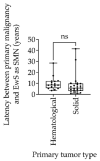Ewing Sarcoma as Secondary Malignant Neoplasm-Epidemiological and Clinical Analysis of an International Trial Registry
- PMID: 36497417
- PMCID: PMC9735743
- DOI: 10.3390/cancers14235935
Ewing Sarcoma as Secondary Malignant Neoplasm-Epidemiological and Clinical Analysis of an International Trial Registry
Abstract
Ewing sarcoma (EwS) is the second most common bone and soft tissue tumor, affecting primarily adolescents and young adults. Patients with secondary EwS are excluded from risk stratification in several studies and therefore do not benefit from new therapies. More knowledge about patients with EwS as secondary malignant neoplasms (SMN) is needed to identify at-risk patients and adapt follow-up strategies. Epidemiology, clinical characteristics, and survival analyses of EwS as SMN were analyzed in 3844 patients treated in the last three consecutive international EwS trials, EICESS 92, Euro-E.W.I.N.G. 99, and EWING 2008. Forty-two cases of EwS as SMN (approximately 1.1% of all patients) were reported, preceded by a heterogeneous group of malignancies, mainly acute lymphoblastic leukemias (n = 7) and lymphomas (n = 7). Three cases of EwS as SMN occurred in the presumed radiation field of the primary tumor. The median age at diagnosis of EwS as SMN was 19.4 years (range, 5.9-72) compared with 10.8 years (range, 0.9-51.2) for primary EwS. The median interval between first malignancy and EwS diagnosis was 7.4 years. The 3-year overall survival (OS)/event-free survival (EFS) was 0.69 (SE = 0.09)/0.53 (SE = 0.10) for localized patients and 0.36 (SE = 0.13)/0.29 (SE = 0.12) for metastatic patients (OS: p = 0.02; EFS: p = 0.03). Survival in patients with EwS as SMN did not differ between hematologic or solid primary malignancies. EwS as SMN is rare; however, survival is similar to that of primary EwS, and its risk-adjusted treatment should be curative, especially in localized patients.
Keywords: Ewing sarcoma; cancer survivor; childhood cancer; secondary malignancy; secondary malignant neoplasms.
Conflict of interest statement
The authors declare no conflicts of interest.
Figures




References
-
- Gatta G., Botta L., Rossi S., Aareleid T., Bielska-Lasota M., Clavel J., Dimitrova N., Jakab Z., Kaatsch P., Lacour B., et al. Childhood cancer survival in Europe 1999-2007: Results of EUROCARE-5--a population-based study. Lancet Oncol. 2014;15:35–47. doi: 10.1016/S1470-2045(13)70548-5. - DOI - PubMed
-
- CCI Europe. [(accessed on 19 July 2022)]. Available online: https://ccieurope.eu/
-
- Bhakta N., Liu Q., Ness K.K., Baassiri M., Eissa H., Yeo F., Chemaitilly W., Ehrhardt M.J., Bass J., Bishop M.W., et al. The cumulative burden of surviving childhood cancer: An initial report from the St Jude Lifetime Cohort Study (SJLIFE) Lancet. 2017;390:2569–2582. doi: 10.1016/S0140-6736(17)31610-0. - DOI - PMC - PubMed
-
- Curtis R.E., Freedman D.M., Ron E., Ries L.A.G., Hacker D.G., Edwards B.K., Tucker M.A., Fraumeni J.F. Jr., editors. New Malignancies Among Cancer Survivors: SEER Cancer Registries, 1973-2000. National Cancer Institute NIH; Bethesda, MD, USA: 2006. NIH Publ. No. 05-5302.
Grants and funding
LinkOut - more resources
Full Text Sources

